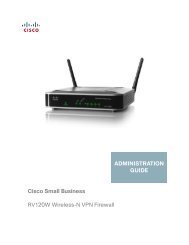Cisco Catalyst 6500 Supervisor 2T Architecture - Ipland
Cisco Catalyst 6500 Supervisor 2T Architecture - Ipland
Cisco Catalyst 6500 Supervisor 2T Architecture - Ipland
Create successful ePaper yourself
Turn your PDF publications into a flip-book with our unique Google optimized e-Paper software.
White PaperIts other main function was to create the CEF forwarding tables that are programmed into the PFC hardware memorytables (through the SP). The SP complex was responsible for performing Layer 2 control plane services, managingsystem power as well as programming various hardware elements in the switch. The IOS image that ran on theseprevious MSFCs, while downloaded from http://www.cisco.com as one binary image file, was in fact two discreteimages: one that ran on the RP CPU complex and one that ran on the SP CPU complex.The most important enhancement of the MSFC5 is the move from the dual CPU complex (RP/SP) to a single CPUcomplex that combines the RP and SP complexes into one. As such, this also introduces a new IOS image for the<strong>Supervisor</strong> <strong>2T</strong> that combines the previous two running images into one.Another valuable enhancement of this new MSFC5 is the introduction of a Connectivity Management Processor(CMP). The CMP is a stand-alone CPU that the administrator can use to perform a variety of remote managementservices. Examples of how the CMP can be used include:● System recovery of the control plane● System resets and reboots● The copying of IOS image files should the primary IOS image be corrupted or deletedThe CMP and the RP share the same console through a programmable multiplexor. By default, the firmwareprograms the multiplexor so the RP console is active on the front panel. The multiplexor intercepts specific escapesequences that instruct it to switch from one console to the other.If the sequence (Ctrl-C, Shift-M) is used three consecutive times, the multiplexor will switch the console to the CMP.If the sequence (Ctrl-R, Shift-M) is used three consecutive times, the multiplexor will switch back to the RP console.External IP connectivity to the CMP is provided by a new 10/100/1000 RJ-45 management interface on the frontpanel. This port can then be configured with an IP address, gateway, and connection method (for example, Telnetand SSH). The user can then access and control the system remotely, even if the RP is currently down.The specifications for the MSFC5 CPU complex as compared to the MSFC3 (<strong>Supervisor</strong> 720) are shown in thefollowing table:Table 8.MSFC5 vs. MSFC3Feature MSFC3 (<strong>Supervisor</strong> 720-10G) MSFC5 (<strong>Supervisor</strong> <strong>2T</strong>)CP CPU speedSP CPU - 600 MhzRP CPU - 600 MhzDual core with each core @ 1.5 GhzNumber CPU cores 1 2Connectivity Management Processor (CMP)CPUNo CMPSingle core @ 266 Mhz32 MB boot flash256 MB system memoryNVRAM 2 MB 4 MBOBFL flash N/A 4 MBBoot diskSP CPU - 1 GBRP CPU - 64 MBCF based - 1 GBCF card on <strong>Supervisor</strong> front panel Yes - 1 CF Slot Yes - 1 CF SlotDRAMSP - Up to 1 GBRP - Up to 1 GB2 GB (non-XL)4 GB (XL)© 2011-2012 <strong>Cisco</strong> and/or its affiliates. All rights reserved. This document is <strong>Cisco</strong> Partner Confidential Information. Page 14 of 46
















